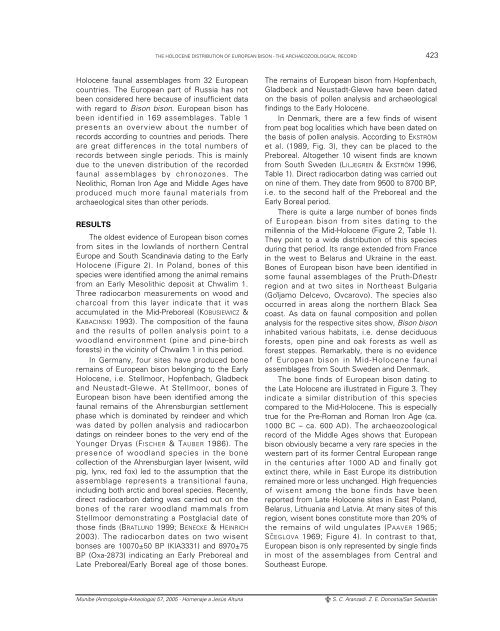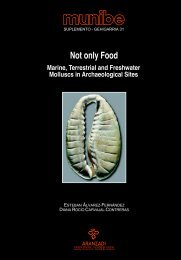The Holocene distribution of European bison – the ... - Aranzadi
The Holocene distribution of European bison – the ... - Aranzadi
The Holocene distribution of European bison – the ... - Aranzadi
You also want an ePaper? Increase the reach of your titles
YUMPU automatically turns print PDFs into web optimized ePapers that Google loves.
THE HOLOCENE DISTRIBUTION OF EUROPEAN BISON - THE ARCHAEOZOOLOGICAL RECORD 423<br />
<strong>Holocene</strong> faunal assemblages from 32 <strong>European</strong><br />
countries. <strong>The</strong> <strong>European</strong> part <strong>of</strong> Russia has not<br />
been considered here because <strong>of</strong> insufficient data<br />
with regard to Bison <strong>bison</strong>. <strong>European</strong> <strong>bison</strong> has<br />
been identified in 169 assemblages. Table 1<br />
presents an overview about <strong>the</strong> number <strong>of</strong><br />
records according to countries and periods. <strong>The</strong>re<br />
are great differences in <strong>the</strong> total numbers <strong>of</strong><br />
records between single periods. This is mainly<br />
due to <strong>the</strong> uneven <strong>distribution</strong> <strong>of</strong> <strong>the</strong> recorded<br />
faunal assemblages by chronozones. <strong>The</strong><br />
Neolithic, Roman Iron Age and Middle Ages have<br />
produced much more faunal materials from<br />
archaeological sites than o<strong>the</strong>r periods.<br />
RESULTS<br />
<strong>The</strong> oldest evidence <strong>of</strong> <strong>European</strong> <strong>bison</strong> comes<br />
from sites in <strong>the</strong> lowlands <strong>of</strong> nor<strong>the</strong>rn Central<br />
Europe and South Scandinavia dating to <strong>the</strong> Early<br />
<strong>Holocene</strong> (Figure 2). In Poland, bones <strong>of</strong> this<br />
species were identified among <strong>the</strong> animal remains<br />
from an Early Mesolithic deposit at Chwalim 1.<br />
Three radiocarbon measurements on wood and<br />
charcoal from this layer indicate that it was<br />
accumulated in <strong>the</strong> Mid-Preboreal (KOBUSIEWICZ &<br />
KABACINSKI<br />
´ 1993). <strong>The</strong> composition <strong>of</strong> <strong>the</strong> fauna<br />
and <strong>the</strong> results <strong>of</strong> pollen analysis point to a<br />
woodland environment (pine and pine-birch<br />
forests) in <strong>the</strong> vicinity <strong>of</strong> Chwalim 1 in this period.<br />
In Germany, four sites have produced bone<br />
remains <strong>of</strong> <strong>European</strong> <strong>bison</strong> belonging to <strong>the</strong> Early<br />
<strong>Holocene</strong>, i.e. Stellmoor, Hopfenbach, Gladbeck<br />
and Neustadt-Glewe. At Stellmoor, bones <strong>of</strong><br />
<strong>European</strong> <strong>bison</strong> have been identified among <strong>the</strong><br />
faunal remains <strong>of</strong> <strong>the</strong> Ahrensburgian settlement<br />
phase which is dominated by reindeer and which<br />
was dated by pollen analysis and radiocarbon<br />
datings on reindeer bones to <strong>the</strong> very end <strong>of</strong> <strong>the</strong><br />
Younger Dryas (FISCHER & TAUBER 1986). <strong>The</strong><br />
presence <strong>of</strong> woodland species in <strong>the</strong> bone<br />
collection <strong>of</strong> <strong>the</strong> Ahrensburgian layer (wisent, wild<br />
pig, lynx, red fox) led to <strong>the</strong> assumption that <strong>the</strong><br />
assemblage represents a transitional fauna,<br />
including both arctic and boreal species. Recently,<br />
direct radiocarbon dating was carried out on <strong>the</strong><br />
bones <strong>of</strong> <strong>the</strong> rarer woodland mammals from<br />
Stellmoor demonstrating a Postglacial date <strong>of</strong><br />
those finds (BRATLUND 1999; BENECKE & HEINRICH<br />
2003). <strong>The</strong> radiocarbon dates on two wisent<br />
bonses are 10070±50 BP (KIA3331) and 8970±75<br />
BP (Oxa-2873) indicating an Early Preboreal and<br />
Late Preboreal/Early Boreal age <strong>of</strong> those bones.<br />
<strong>The</strong> remains <strong>of</strong> <strong>European</strong> <strong>bison</strong> from Hopfenbach,<br />
Gladbeck and Neustadt-Glewe have been dated<br />
on <strong>the</strong> basis <strong>of</strong> pollen analysis and archaeological<br />
findings to <strong>the</strong> Early <strong>Holocene</strong>.<br />
In Denmark, <strong>the</strong>re are a few finds <strong>of</strong> wisent<br />
from peat bog localities which have been dated on<br />
<strong>the</strong> basis <strong>of</strong> pollen analysis. According to EKSTRÖM<br />
et al. (1989, Fig. 3), <strong>the</strong>y can be placed to <strong>the</strong><br />
Preboreal. Altoge<strong>the</strong>r 10 wisent finds are known<br />
from South Sweden (LILJEGREN & EKSTRÖM 1996,<br />
Table 1). Direct radiocarbon dating was carried out<br />
on nine <strong>of</strong> <strong>the</strong>m. <strong>The</strong>y date from 9500 to 8700 BP,<br />
i.e. to <strong>the</strong> second half <strong>of</strong> <strong>the</strong> Preboreal and <strong>the</strong><br />
Early Boreal period.<br />
<strong>The</strong>re is quite a large number <strong>of</strong> bones finds<br />
<strong>of</strong> <strong>European</strong> <strong>bison</strong> from sites dating to <strong>the</strong><br />
millennia <strong>of</strong> <strong>the</strong> Mid-<strong>Holocene</strong> (Figure 2, Table 1).<br />
<strong>The</strong>y point to a wide <strong>distribution</strong> <strong>of</strong> this species<br />
during that period. Its range extended from France<br />
in <strong>the</strong> west to Belarus and Ukraine in <strong>the</strong> east.<br />
Bones <strong>of</strong> <strong>European</strong> <strong>bison</strong> have been identified in<br />
some faunal assemblages <strong>of</strong> <strong>the</strong> Pruth-Dnestr ˇ<br />
region and at two sites in Nor<strong>the</strong>ast Bulgaria<br />
(Goljamo ˇ Delcevo, Ovcarovo). <strong>The</strong> species also<br />
occurred in areas along <strong>the</strong> nor<strong>the</strong>rn Black Sea<br />
coast. As data on faunal composition and pollen<br />
analysis for <strong>the</strong> respective sites show, Bison <strong>bison</strong><br />
inhabited various habitats, i.e. dense deciduous<br />
forests, open pine and oak forests as well as<br />
forest steppes. Remarkably, <strong>the</strong>re is no evidence<br />
<strong>of</strong> <strong>European</strong> <strong>bison</strong> in Mid-<strong>Holocene</strong> faunal<br />
assemblages from South Sweden and Denmark.<br />
<strong>The</strong> bone finds <strong>of</strong> <strong>European</strong> <strong>bison</strong> dating to<br />
<strong>the</strong> Late <strong>Holocene</strong> are illustrated in Figure 3. <strong>The</strong>y<br />
indicate a similar <strong>distribution</strong> <strong>of</strong> this species<br />
compared to <strong>the</strong> Mid-<strong>Holocene</strong>. This is especially<br />
true for <strong>the</strong> Pre-Roman and Roman Iron Age (ca.<br />
1000 BC <strong>–</strong> ca. 600 AD). <strong>The</strong> archaeozoological<br />
record <strong>of</strong> <strong>the</strong> Middle Ages shows that <strong>European</strong><br />
<strong>bison</strong> obviously became a very rare species in <strong>the</strong><br />
western part <strong>of</strong> its former Central <strong>European</strong> range<br />
in <strong>the</strong> centuries after 1000 AD and finally got<br />
extinct <strong>the</strong>re, while in East Europe its <strong>distribution</strong><br />
remained more or less unchanged. High frequencies<br />
<strong>of</strong> wisent among <strong>the</strong> bone finds have been<br />
reported from Late <strong>Holocene</strong> sites in East Poland,<br />
Belarus, Lithuania and Latvia. At many sites <strong>of</strong> this<br />
region, wisent bones constitute more than 20% <strong>of</strong><br />
<strong>the</strong> remains <strong>of</strong> wild ungulates (PAAVER 1965;<br />
SCEGLOVA ˇ 1969; Figure 4). In contrast to that,<br />
<strong>European</strong> <strong>bison</strong> is only represented by single finds<br />
in most <strong>of</strong> <strong>the</strong> assemblages from Central and<br />
Sou<strong>the</strong>ast Europe.<br />
Munibe (Antropologia-Arkeologia) 57, 2005 · Homenaje a Jesús Altuna<br />
S. C. <strong>Aranzadi</strong>. Z. E. Donostia/San Sebastián
















